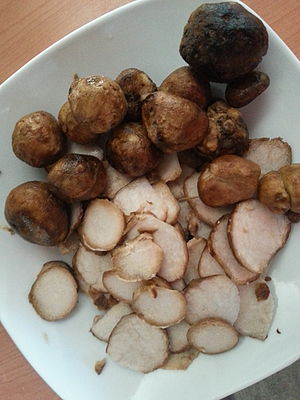Kalahari truffle
| Kalahari truffle | ||||||||||||
|---|---|---|---|---|---|---|---|---|---|---|---|---|

Kalahari truffle |
||||||||||||
| Systematics | ||||||||||||
|
||||||||||||
| Scientific name of the genus | ||||||||||||
| Kalaharituber | ||||||||||||
| Bustard & Kagan-Zur | ||||||||||||
| Scientific name of the species | ||||||||||||
| Kalaharituber pfeilii | ||||||||||||
| ( Hennings ) Trappe & Kagan-Zur |
The Kalahari truffle ( Kalaharituber pfeilii , syn. Terfezia pfeilii ) is a subterranean ( hypogean ) fruiting mushroom from the family of the cup relatives (Pezizaceae).
features
Macroscopic features
The wrinkled fruiting bodies that grow underground are roughly spherical and 6 to 6.5 centimeters in size. They are finely haired and surrounded by a peridia about 1 millimeter thick. Their color is dark brown, with yellowish wrinkles. Inside, their flesh is white with brownish veins. It has a strong "mushroom" smell.
Microscopic features
The almost spherical to ellipsoidal, rarely egg-shaped asci are 70 to 100 by 50 to 80 micrometers and have 5 to 8 spherical spores . These measure 16 to 22, sometimes up to 26 micrometers. They are initially hyaline and later (light) brown in color. The spores have a two-layer cell wall 1.5 micrometers thick, which reacts light yellow to light orange under Melzer's reagent , and with potassium hydroxide they appear fine black.
Distribution and ecology
The Kalahari truffle is a very rare mushroom. It is native to southern Africa . It is best known for its occurrence in the Kalahari .
The species lives a few centimeters below the surface of the earth in a mycorrhizal symbiosis with certain plants. Original symbionts are certain types of acacia . Today it is often associated with certain melon ( watermelon , various wild species, ...) and feather grass species ( Stipagrostis spp. ). It lives in very sandy, weakly acidic soils and has little water requirement. The fruiting depends on the fertility of rainfall and typically takes place after the rainy season.
use

Kalahari truffles are edible and are used as an edible mushroom . They are a specialty in Namibian cuisine . They are harvested here in years with a rainy period from the end of March to around the beginning of May. People look for Kalahari truffles on the basis of typical cracks or swellings in the floor or known symbiotic plants. Traditionally they are collected in the Kalahari by members of the San ethnic group .
Apparently the fruiting bodies of the low - spore truffle ( Tuber oligospermum ), a culinary inferior type of truffle , which are exported en masse from Morocco to Europe , are sometimes labeled as "Kalahari truffles".
Systematics and taxonomy
The official first description comes from the article by Paul Christoph Hennings published in 1895 about the "Fungi camerunenses I" (mushrooms of Cameroon 1), in which he called the species " Terfezia pfeilii " in honor of Count Joachim von Pfeil . The count had brought him a pickled sample from northwestern Namibia. Molecular genetic studies published in 2005 by scientists from Ben Gurion University in the Negev (Israel) suggested that it was assigned to a new genus.
Popular names are Nǀabba ( Khoisan ), “Mana” ( Khoekhoegowab ) or “Omatumbula” ( Oshivambo ) and refer, among other things, to the hypogean way of life or the superficial color of the fruit bulbs .
- ↑ Note: This article contains characters from the alphabet of the Khoisan languages spoken in southern Africa . The display contains characters of the click letters ǀ , ǁ , ǂ and ǃ . For more information on the pronunciation of long or nasal vowels or certain clicks , see e.g. B. under Khoekhoegowab .
Individual evidence
- ↑ a b c Yael Ferdman, Sharon Aviram, Nurit Roth-Bejerano, James M. Trappe, Varda Kagan-Zur: Phylogenetic studies of Terfezia pfeilii and Choiromyces echinulatus (Pezizales) support new genera for southern African truffles: Kalaharituber and Eremiomyces . In: British Mycological Society (Ed.): Mycological Research . tape 109 , no. 2 , February 2005, p. 242 , doi : 10.1017 / S0953756204001789 , PMID 15839107 (English).
- ↑ a b Paul Christoph Hennings: Fungi camerunenses I . In: Botanical yearbooks for systematics of plant history and plant geography . tape 22 , 1897, pp. 75 ( botanicus.org ).
- ^ Varda Kagan-Zur, Nurit Roth-Bejerano: Desert Truffles . In: Fungi . tape 1 , no. 3 , 2008, p. 32–37 (English, fungimag.com [PDF]).
- ↑ a b c Luise Hoffmann: The Kalahari truffle - delicacies from the sand . In: Allgemeine Zeitung . Democratic Media Holdings Pty Ltd., Windhoek April 3, 2008 ( com.na ).
- ↑ René Flammer: Kalahari truffles from Morocco . In: Swiss Journal for Mushroom Science (SZP / BSM) - Periscope . No. 30 (2010–6) , 2010, pp. 240 f . ( giftpilze.ch [PDF]).
- ↑ Nailoke Paulina Kadhila-Muandingi, Fabiana Sinvula Mubiana: The kweek van sampioene . 'n handleiding vir beginners. Ed .: University of Namibia. (Afrikaans, unam.na [PDF]).